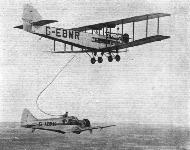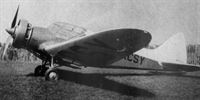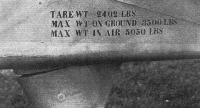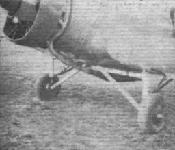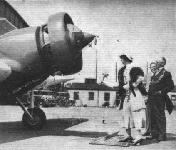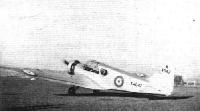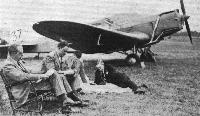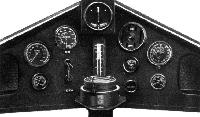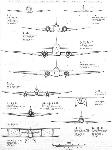
Описание
Страна : Великобритания
Год : 1933
Пяти-/шестиместный легкий транспортный самолет
Airspeed AS.5 Courier
Первым серийным самолетом фирмы "Airspeed" стал AS.5 Courier, разработанный одним из директоров компании А. Хесселем Тилтманом. Он был сделан на основе проекта, представленного еще в 1931 году, но из-за нехватки средств у новой компании к постройке прототипа приступили только в сентябре 1932 года.
Самолет смешанной конструкции, выполненный по схеме свободнонесущего моноплана с низкорасположенным крылом, отличался важной новинкой - убирающимися стойками шасси. Первый прототип, на котором был установлен незакапотированный мотор воздушного охлаждения Armstrong Siddeley Lynx IVC мощностью 240 л. с. (179 кВт), поднялся в воздух 11 апреля 1933 года. Силовую установку позднее доработали, закрыв головки цилиндров кольцом Тауненда. Серийный "британский" вариант самолета получил обозначение AS.5A. Альтернативный "колониальный" вариант был оснащен мотором воздушного охлаждения Armstrong Siddeley Cheetah V мощностью 305 л. с. и получил обозначение AS.5B.
В феврале 1934 года британские ВВС (RAF) приобрели один пяти-/шестиместный AS.5A, для использования в качестве связного самолета. В 1935 году его вернули на фирму для установки устройств, уменьшающих подъемную силу крыла, так как Courier оказался чересчур "летучим" - поднявшись в воздух, он приземлялся крайне неохотно.
Всего построили 16 экземпляров Courier, 10 из которых в годы Второй мировой войны использовались в качестве связных и транспортных машин. В их число входил и экземпляр, купленный ранее военными, а остальные машины были мобилизованы у гражданских владельцев. Лишь один служивший в RAF Courier пережил войну и был возвращен на гражданскую службу 18 января 1946 года.
ТАКТИКО-ТЕХНИЧЕСКИЕ ХАРАКТЕРИСТИКИ
Airspeed AS.5B Courier
Тип: пяти-/шестиместный легкий транспортный самолет.
Силовая установка: поршневой мотор воздушного охлаждения Armstrong Siddeley Cheetah V, взлетной мощностью 305 л. с. (227 кВт)
Летные характеристики: максимальная скорость на уровне моря 226 км/ч; крейсерская скорость 233 км/ч на высоте 305 м; максимальная скороподъемность на уровне моря 286 м/мин; потолок 5180 м; дальность полета 1030 км
Масса: пустого 1056 кг; максимальная взлетная 1814 кг; максимальная полезная нагрузка 408 кг
Размеры: размах крыла 14,33 м; длина 8,69 м; площадь крыла 23,23 м2
Описание:
- Airspeed AS.5 Courier
- Flight, October 1932
AIRSPEED A.S. 5 - Flight, December 1933
DEMONSTRATING THE “COURIER" - Flight, April 1936
MODERN LIGHT AIRCRAFT REVIEWED
Фотографии
-
Aeroplane Monthly 1978-03 / D.Middleton - Courier Airspeed's innovator (1)
Регистрационный номер: G-ABXN [13] -
Aeroplane Monthly 1978-03 / D.Middleton - Courier Airspeed's innovator (1)
Регистрационный номер: G-ABXN [13] The prototype Courier, G-ABXN, made its initial flights without the Townend ring fitted. It was later fitted to this and all subsequent Couriers.
-
Aeroplane Monthly 1988-03 / J.Stroud - Wings of Peace
Регистрационный номер: G-ABXN [13] The prototype Airspeed A.S.5 Courier, G-ABXN, being flown by G. H. Stainforth in April 1933, shortly after its first flight. The Townend ring around the 240 h.p. Lynx IVC radial engine added at least 15 m.p.h. to the aircraft’s speed.
-
Мировая Авиация 20
Регистрационный номер: G-ABXN [13] Оснащенный убирающимся шасси Courier имел необычно высокую крейсерскую скорость полета. Один из таких самолетов использовался Аланом Кобхэмом при неудачной попытке совершить беспосадочный перелет из Англии в Индию с использованием дозаправки в воздухе.
-
Aeroplane Monthly 1978-04 / D.Middleton - Courier Airspeed's innovator (2)
Регистрационный номер: G-ABXN [13] FOR FAST TRAVEL: Our photographer shows what the "Courier" looks like with the undercarriage up and down. This machine is for Commercial Airways Ltd which operate from Abridge Aerodrome, Essex.
-
Авиация и Космонавтика 2020-07 / Ю.Кузьмин - Дозаправка в воздухе: от первых опытов к первому в мире беспилотному заправщику
Регистрационный номер: G-ABXN [13] Handley Page W10 G-EBMM refuels Sir Alan Cobham's Airspeed Courier, G-ABXN, during the ill-fated record flight to India in 1934. After refuelling the Courier on September 22, the W10 broke-up in mid-air and crashed at Aston Clinton, Buckinghamshire, killing all four crew. The Courier later had to force land at Hal Far, Malta, due to engine problems.
AS.5 «Курьер» дозаправляется от W.10 над Портсмутом, Великобритания. На фотографии запечатлен момент тренировки перед перелётом в Индию.Другие самолёты на фотографии: Handley Page H.P.18 (W.8) / H.P.30 (W.10) - Великобритания - 1919
-
Aeroplane Monthly 1974-02 / Skywriters
Регистрационный номер: G-ABXN [13] Airspeed Courier G-ABXN takes on fuel from Handley Page W.10 tanker G-EBMR in 1934, watched by D.H.60 Moth G-AADB.
Другие самолёты на фотографии: De Havilland Moth / D.H.60 - Великобритания - 1925Handley Page H.P.18 (W.8) / H.P.30 (W.10) - Великобритания - 1919
-
Flight 1934-09 / Flight
Регистрационный номер: G-ABXN [13] PRACTICE MAKES PERFECT: Sir Alan Cobham carries out a refuelling test at Portsmouth in preparation for his forthcoming non-stop flight to India with Sqd. Ldr. Helmore in the Airspeed "Courier." The "tanker" seen above is Sir Alan's Handley Page W.10 (ex City of Pretoria of Imperial Airways).
Другие самолёты на фотографии: Handley Page H.P.18 (W.8) / H.P.30 (W.10) - Великобритания - 1919
-
Flight 1934-09 / Flight
Регистрационный номер: G-ABXN [13] 21 сентября 1934г. сэр Алан Кобхэм предпринял попытку безостановочного перелета из Англии в Индию на самолете Airspeed AS.5 Courier C-ABXN. Над Портсмутом и Мальтой сэр Алан планировал дозаправку в воздухе от собственных самолетов Handley Page W.10, а над Абукиром и Басрой - от самолетов ВВС Великобритании. Прием топлива был благополучно выполнен над Сельси-Билл (Сассекс) и над Мальтой, но поломка тяги управления двигателем заставила летчика выполнить вынужденную посадку на Мальте. Попытка беспосадочного перелета потерпела неудачу.
FILLING UP: A unique photograph taken from the "Youth of New Zealand," showing Sqd. Ldr. Helmore holding the hose into the mouthpiece ready for refuelling while flying under the tanker, whose bottom wing comes into the picture on the left. -
Aeroplane Monthly 1978-03 / D.Middleton - Courier Airspeed's innovator (1)
Регистрационный номер: G-ABXN [13] The prototype Courier, G-ABXN, with the ring fitted.
-
Jane's All the World Aircraft 1980 / Encyclopedia of Aviation - Aircraft A-Z - v1
Регистрационный номер: G-ABXN [13] Airspeed AS.5 Courier.
-
Aeroplane Monthly 1978-03 / D.Middleton - Courier Airspeed's innovator (1)
Регистрационный номер: G-ACJL [6], VH-UUF [6] WITH WHEELS DOWN: An Airspeed "Courier" (Siddeley "Cheetah"), similar to that which will be demonstrated at Copenhagen.
-
Aeroplane Monthly 1978-03 / D.Middleton - Courier Airspeed's innovator (1)
Регистрационный номер: G-ACJL [6], VH-UUF [6] View of the first production Courier, G-ACJL, painted in the two-tone blue colour scheme of Aircraft Exchange & Mart Ltd. It competed in the 1934 MacRobertson Race, and was registered in Australia as VH-UUF in 1935.
The excellent view from the Courier's cabin is well shown in this flying picture, taken while the retractable undercarriage was "at the ready." -
Flight 1935-12 / Flight
Регистрационный номер: G-ACJL [6], VH-UUF [6] Two high-speed low-wing monoplanes, the Miles Falcon Six and the Airspeed Courier.
Другие самолёты на фотографии: Miles Falcon M.3 / Hawcon M.6 - Великобритания - 1934
-
Aeroplane Monthly 1978-04 / D.Middleton - Courier Airspeed's innovator (2)
Регистрационный номер: G-ACJL [6], VH-UUF [6] THE "COURIER" IN THE RACE: Sqd. Ldr. Stodart's Airspeed "Courier" coming up to the hangar on Sunday afternoon. This machine arrived immediately after the "Viceroy."
The first production Courier, G-ACJL was flown into fourth place in the handicap section of the MacRobertson Race in October 1934. -
Aeroplane Monthly 1984-11 / W.Clennel - Mildenhall memories
Регистрационный номер: G-ACJL [6], VH-UUF [6] TOEING THE LINE: Another view over the heads of the crowd. The nearest machine is the "Puss Moth" flown by Mr. C. J. Melrose, next to it are the Airspeed "Courier" A.S.5. (Sqd. Ldr. Stodart and Mr. K. G. Stodart), and Flt. Lt. Shaw's British Klemm "Eagle." These machines were in the Handicap Race.
Some of the last MacRobertson Race competitors about to take off early on the morning of October 20, 1934. Nearest the camera is C. J. Melrose in a Puss Moth, with Sqn Ldr Stodart’s Airspeed Courier next to it. Flt Lt Shaw's British Klemm Eagle wears race number 47.Другие самолёты на фотографии: British Klemm BK-1 Eagle - Великобритания - 1934De Havilland Puss Moth / D.H.80 - Великобритания - 1929
-
Aeroplane Monthly 1988-03 / J.Stroud - Wings of Peace
Регистрационный номер: G-ACLF [3], X9342 [3] G-ACLF as an AS.5B with Cheetah V engine. This was the first Colonial model. After demonstration in India it served North Eastern Airways, by then fitted with a Lynx IVC.
-
Aeroplane Monthly 1978-04 / D.Middleton - Courier Airspeed's innovator (2)
Регистрационный номер: G-ACLF [3], X9342 [3] Courier G-ACLF in the colours of R. K. Dundas Ltd. posed with a Rolls-Royce Phantom II. ’LF passed to North Eastern Airways Ltd at Croydon and then to Portsmouth. Southsea and Isle of Wight Aviation Ltd. It was impressed into RAF service as X9342 but dismantled at Kemble in 1943.
-
Aeroplane Monthly 1978-03 / D.Middleton - Courier Airspeed's innovator (1)
Регистрационный номер: G-ACLF [3], X9342 [3] SPEED FOR INDIA: The "Cheetah"engined "Courier" of R. Dundas, Ltd., on the tarmac at Almaza Aerodrome, Cairo. Lord Ronaldshay, Managing Director of the Company, is flying to India in this machine, piloted by Mr. C. E. Kelly.
The third production Courier, G-ACLF, at Almaza Airport, Cairo, in December 1933, on its way to India for demonstration by R. K. Dundas. 'LF was later impressed into RAF service and was finally dismantled at Kemble in 1943. -
Aeroplane Monthly 1978-04 / D.Middleton - Courier Airspeed's innovator (2)
Регистрационный номер: G-ACLR [2], X9344 [2] Courier G-ACLR flew with PSIOW, was impressed as X9344 and crashed at Bolt Head Aerodrome, Devon, in August 1942.
-
Air Enthusiast 2000-11 / G.Warner - Founding Fathers (2)
Регистрационный номер: G-ACLR [2], X9344 [2] Portsmouth, Southsea and Isle of Wight Aviation Airspeed Courier G-ACLR.
-
Aeroplane Monthly 1978-04 / D.Middleton - Courier Airspeed's innovator (2)
Регистрационный номер: G-ACLT [4], X9394 [4] Courier G-ACLT flew with North Eastern Airways and Air Taxis Ltd before being impressed as X9394.
-
Aeroplane Monthly 1978-03 / D.Middleton - Courier Airspeed's innovator (1)
Регистрационный номер: G-ACLT [4], X9394 [4] Courier G-ACLT in the colours of Bouts Airlines, during an experimental London-Manchester express freight service in May 1934.
-
Flight 1934-05 / Flight
Регистрационный номер: G-ACLT [4], X9394 [4] CHAPTER II: Loading up the two Airspeed "Couriers" at Hanworth before their journey to Manchester.
-
Flight 1933-12 / Flight
Регистрационный номер: G-ACLT [4], X9394 [4] "CHEAP SPEED": At the Airports Conference Maj. Thornton said that if he were selling aeroplanes, this would be his slogan. In the Airspeed "Courier" it is provided to a marked extent, the "Cheetah"-engined version (nearest the camera) having a maximum speed of 170-172 m.p.h. and a cruising speed of about 152 m.p.h. As the engine is of 300 h.p. only, and the machine carries six people, this must be regarded as very cheap speed indeed.
-
Aeroplane Monthly 1978-04 / D.Middleton - Courier Airspeed's innovator (2)
Регистрационный номер: G-ACSY Courier G-ACSY was operated by London, Scottish & Provincial Airways Ltd until it crashed at Sevenoaks, Kent, on September 29, 1934.
-
Aeroplane Monthly 1988-04 / Skywriters
Регистрационный номер: G-ACVF EAFS Courier G-ACVF, with fixed undercarriage, being flown by Sqn Ldr R. J. Jones over Southend on March 30, 1947. The aircraft was withdrawn from use nine months later.
-
Aeroplane Monthly 1993-11 / H.Shore - Flea fever (1)
Регистрационный номер: G-ADAX [2] Airspeed A.S.5 Courier G-ADAX in the livery of Portsmouth, Southsea & Isle of Wight Aviation Ltd.
-
Aeroplane Monthly 1988-03 / J.Stroud - Wings of Peace
Регистрационный номер: G-ADAX [2] Portsmouth Southsea & Isle of Wight Aviation's AS.5A G-ADAX.
-
Flight 1938-01 / Flight
Quick and systematic handling of holiday passengers and joy-riders has been brought to a fine art by Portsmouth, Southsea and Isle of Wight Aviation. Their I.O.W. ferry has introduced thousands to flying.
The Portsmouth, Southsea and Isle of Wight Aviation Ltd. fleet at Portsmouth in 1937. Four Airspeed Couriers are lined up on the left and a Fox Moth and two Monospars stand behind them. The ST-10 G-ACTS won the 1934 King’s Cup Air Race. It was a prototype and never went into production, but served with PSIOW on the Ryde Ferry.Другие самолёты на фотографии: De Havilland Fox Moth / D.H.83 - Великобритания - 1932General Aircraft Monospar ST-4 - ST-12 - Великобритания - 1932
-
Flight 1934-09 / Flight
AN INNOVATION: The official weights allowed by the Certificate of Airworthiness on Sir Alan Cobham's Airspeed "Courier" as prepared for refuelling in the air. This is probably the first time "Max Wt In Air" has appeared on any aeropiane.
-
Flight 1934-09 / Flight
Aeroplane with the "Blanvac" silencer fitted in the exhaust system: an Airspeed "Courier" (Siddeley "Lynx");
-
Flight 1933-09 / Flight
(from left to right) A. L. Naish and B. Brady, who hold the sole selling agency for England, Ireland and Wales for this machine, N. S. Norway, A. H. Tiltman, and Lord Granthorpe (Chairman), the Directors of Airspeed, Ltd.
-
Flight 1934-06 / Flight
A LINK WITH THE SOUTH: Southern & Central Air Lines and London, Scottish & Provincial Airways are operating a connecting service between Southampton and Hull. The Mayoress of Southampton, Mrs. W. D. Buck, is here seen christening one of the Airspeed "Couriers," employed on this service, City of Southampton, at the Municipal Airport of Southampton.
-
Flight 1934-02 / Flight
Регистрационный номер: K4047 [6] FOR FAST TRAVEL: The ground view show an Airspeed "Courier" ("Lynx IV") which has just been delivered to the Royal Air Force, presumably for communications work.
-
Aeroplane Monthly 1978-03 / D.Middleton - Courier Airspeed's innovator (1)
Регистрационный номер: K4047 [6] -
Flight 1936-06 / Flight Advertisements
Регистрационный номер: K4047 [6] Rapid inter-communication between Staff Headquarters, Divisional Headquarters and the armies in the field are more necessary in modern warfare than ever before. The Courier with its speed, manoeuvrability, flaps for slow landing, and five comfortable seats is ideal for this purpose.
-
Aeroplane Monthly 1978-03 / D.Middleton - Courier Airspeed's innovator (1)
Регистрационный номер: K4047 [6] The Air Ministry's Courier A.S.5A, K4047, was delivered to the RAF in February 1934. It was later fitted with Shrenk and Handley Page flaps to reduce the aircraft's habit of floating during landing. These flaps are seen in operation in the photograph.
-
Aeroplane Monthly 1978-04 / D.Middleton - Courier Airspeed's innovator (2)
Регистрационный номер: K4047 [6] Envoys in production at Portsmouth, with the Air Ministry's Courier K4047, minus wings, at right.
Другие самолёты на фотографии: Airspeed Envoy / AS.6 - Великобритания - 1934
-
Aeroplane Monthly 1978-11 / D.Middleton - Airspeed's elegant Envoy (2)
Регистрационный номер: K4047 [6] Envoy production at Portsmouth in 1934. Note Courier K4047 behind.
Другие самолёты на фотографии: Airspeed Envoy / AS.6 - Великобритания - 1934
-
Aeroplane Monthly 1977-06 / J.Griffin - Portsmouth Airport 1932-1973
Регистрационный номер: G-ACNZ [4] The only Courier A.S.5C was powered by a 325 h.p. Napier Rapier IV.
-
Flight 1934-06 / Flight
Регистрационный номер: G-ACNZ [4] THE RAPIER "COURIER": Air Vice-Marshal A. E. Borton, Director of D. Napier & Son, Ltd., has had one of his company's "Rapier" engines fitted to this Airspeed "Courier," and has entered the combination in the King's Cup race. A high performance is expected.
-
Aeroplane Monthly 1988-03 / J.Stroud - Wings of Peace
Регистрационный номер: G-ACNZ [4] The Napier Rapier IV installation in the AS.5C G-ACNZ, which averaged 166 m.p.h. in the preliminary heats for the 1934 King's Cup.
Courier G-ACNZ was designated A.S.5C and used as a test-bed for the Rapier IV 325 h.p. engine. This engine drove a four-bladed propeller and greatly reduced the frontal area, with a resultant increase in performance. -
Flight 1934-07 / Flight
Регистрационный номер: G-ACNZ [4] NAPIERIAN LOGS: From left to right, Air Vice-Marshal Borton, Mr. Winter, Mr. Smith, Mr. Savage, and the "Rapier" in the "Courier."
-
Flight 1933-12 / Flight
COMFORT WITH SPEED: A peep into the cabin of the Airspeed "Courier" (Armstrong-Siddeley "Cheetah" engine) which is being flown out to India shortly.
-
Flight 1933-12 / Flight Advertisements
STANDARD EQUIPMENT ON THE "AIRSPEED COURIER." The SMITH instrument panel including, Air Speed Indicator, Altimeter, Engine Speed Indicator, Fore and Aft Level, Oil Gauge and Oil Thermometer.
-
Aeroplane Monthly 1988-06 / Skywriters
Регистрационный номер: G-ABXN [13] Sir Alan Cobham's Airspeed Courier after its forced landing at Hal Far in 1934.
-
Flight 1934-10 / Flight
Регистрационный номер: G-ABXN [13] A RETRACTED LANDING: Sir Alan Cobham's Airspeed "Courier" as it landed at the Halfar Aerodrome, Malta, during his recent attempt on the non-stop flight to India. Sir Alan only just reached the aerodrome by keeping the undercarriage retracted, thus prolonging the glide.
-
Aeroplane Monthly 1978-04 / D.Middleton - Courier Airspeed's innovator (2)
Регистрационный номер: G-ACVE The wreckage of Courier G-ACVE on August 20, 1936, after two men without flying experience crashed on take off attempting to take the aircraft to Spain.
-
Aeroplane Monthly 1984-05 / Skywriters
Регистрационный номер: G-ACJL [6], VH-UUF [6] A model of the Airspeed Courier. The model has a wingspan of 83in, a wing area of 1,100in2 and at a weight of 9 1/2 lb has a wing loading low enough to be as embarrassing as the real thing to land in a small field on a calm day. It floats. I can come in over the boundary ten feet up and still be five feet up when I exit on the far side. Oh for flaps!
-
Aeroplane Monthly 1988-03 / J.Stroud - Wings of Peace
Регистрационный номер: G-ADAY KEITH WOODCOCK’S painting shows Portsmouth Southsea & Isle of Wight Aviation’s Airspeed AS.5A Courier G-ADAY.
-
Flight 1934-07 / Flight
Two views which show the Drag Bracing (left) and the Wing Joint (right). They are of the Airspeed "Courier" and differ only very slightly from the same details in the "Envoy." The Wing Joint is between the centre section and the outer wing extensions, the Drag Bracing comes between the wing spars.
-
Flight 1934-10 / Flight
Другие самолёты на фотографии: Airspeed Envoy / AS.6 - Великобритания - 1934Boeing Model 247 - США - 1933Douglas DC-1 / DC-2 / C-32 / C-39 - США - 1933Fairey Fairey IIIF - Великобритания - 1926Koolhoven FK-41 - Нидерланды - 1928Lockheed Orion 9 - США - 1931Messerschmitt Bf.108 Taifun - Германия - 1934Miles Hawk / M.2 - Великобритания - 1932Pander S-4 Postjager - Нидерланды - 1933
-
Flight 1932-10 / Flight
Airspeed Type A.S.5
- Фотографии







